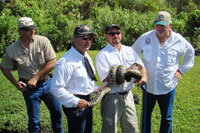No pythons were captured during Florida’s special python hunting season.
Click image to enlarge Biologist Shawn Heflick (third from left) holds a Burmese python in Southern Florida in 2009. Many of these pythons have since died off due to the cold weather in Florida. |
Florida wrapped up its six-week hunting season in the everglades with no pythons captured. The python hunting season, which lasted from March 8 to April 17, was open to everyone in possession of a hunting license and a $26 permit. The Florida Fish and Wildlife Conservation Commission (FWC) began the season to eradicate nonnative species in Southern Florida—in particular the Burmese python. Other “reptiles of concern” that hunters were permitted to remove from designated state-managed lands included the reticulated python, northern and southern African rock python, amethystine or scrub python, green anaconda and Nile monitor.
Conservation biologist Shawn Heflick said that part of the reason no snakes were found is that many of them had already been killed off by the freezing temperatures in Florida in January. Heflick is one of a handful of experienced herpers that has been hunting reptiles of concern in Florida since July 2009.
Appointed by the FWC, the group is slated to continue hunting through December 2010. The group captured 39 pythons in 2009 and has captured 13 so far this year. Heflick, who was the lead trainer for the six-week public season, said it’s harder for less-seasoned hunters to find the snakes.
“Herpers tend to have an image in their heads that they are looking for—certain patterns, shapes, etc.—which indicates ‘snake’ to them,” Heflick said. “Nonherpers wouldn’t have that image because they don’t go out looking for snakes all the time.”
Heflick said participants in the hunt ran the gamut from reptile enthusiasts and amateurs to people who really just wanted to help, adding that there may have been a few hunters out for the pleasure of the kill. The snakes, if found, would have been killed using legal methods, and then reported to the FWC within 36 hours.
Helfick said that knowing the pythons must be killed is one of the hardest parts. This year, however, Heflick and his group of more experienced hunters are allowed to transport the snakes to FWC-approved research facilities. “Another important fact to remember is that when we do euthanize them, we gain a lot of information about what they are doing out there,” he said.
Andrew Wyatt, president of the United States Association of Reptile Keepers (USARK), said, “I think the python hunt was a good proactive way to help the situation, but the cold is what really did it.”
Wyatt pointed to a telemetry study by Dr. Frank Mazzotti, who tracked 10 Burmese pythons in Everglades National Park. Nine of the 10 snakes died, and the tenth was brought in out of the cold. Wyatt estimated that closer to 90 percent of the pythons in Southern Florida died in the cold snap—not 50 percent as the FWC estimated—and Heflick said the numbers fall between 70 percent and 80 percent.
Heflick reported that his group of hunters has been finding far fewer live snakes since the freeze, and that those they do find are usually smaller and younger. He said that it may be easier for the small snakes to find cover and hide.
Though the special six-week hunting season for the public has ended, Heflick plans to participate in his FWC-approved program as long as he is financially able, as the hunters are footing the bill. He said that each python removed makes it harder for the snakes to repopulate. He added, “Ultimately, the population is going to be controlled by Mother Nature like it was this winter. We’ll just lend her a hand!”
Wyatt also said that Florida’s weather will take care of its nonnative reptiles. He cited USARK-accredited best management practices as the best way to move forward, including secure containment of reptiles, environmental protocols, public health and safety protocols, and disaster plans.


